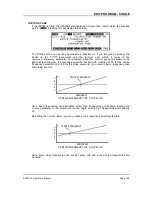
SAMPLE
S3000XL Operator’s Manual
Page 117
One of the inherent problems with sampling is the RAM and it is not possible to have an
endless supply of it installed in the sampler. As a result, our recordings (or samples as
they are more commonly known in the music industry) have to be kept fairly short. In order
to make them last longer so that long notes can be sustained, we need to loop them.
This involves selecting a portion of the sound that will repeat over and over again when
we hold our finger(s) on the keyboard.
LOOP ZONE
LOOP
LOOP
LOOP
The biggest problem, though, is the nature of the sounds you sample. Most musical
instruments have particular resonant frequencies (or ‘formants’ as they are sometimes
called) plus other characteristics such as vibrato, etc.. In the instrument themselves, these
characteristics stay constant regardless of the notes being played but, on a sampler,
because you are transposing the sound up and down (slowing it down and speeding it up
much like a tape recorder), these are also transposed which leads to a phenomena
quaintly referred to as “munchkinisation”. We have all laughed at hearing our voice
speeded up on a tape recorder sounding like some bizarre cartoon character - the same
will happen on a sampler and this is because the voice has formants and other attributes
which do not transpose well. Similarly, the sound’s envelope will change - transposed
down an octave, a percussive attack will sound quite sluggish.
To overcome this, we need to use a technique known as MULTI-SAMPLING - that is,
taking various samples of the instrument at a variety of pitches across its range so that, at
any one time, the sound is never transposed too much and so avoids serious
“munchkinisation” and envelope distortion. Typically, you can get away with one sample
per octave but some difficult instruments with strong formants need more. The saxophone
and piano are two instruments that spring to mind and which are notoriously difficult to
capture.
Another property of an acoustic instrument is that it can make so many sounds
depending on how it’s played. When played softly, the sound is not only quieter but softer
in tone and, when played hard, is louder and brighter. Some instruments have quite
extreme ranges in tone. Coupled with playing techniques (i.e. thumbed and slapped bass,
bowed and plucked violin), to accurately replicate this on a sampler, we can take different
samples according to playing styles. On the S3000XL we have four velocity zones that
allow us to use playing technique to switch between these different samples so that you
could, for example, use velocity to switch between a slow legato viola and an aggressively
bowed viola.
Of course, a lot of the time you can take just a few samples, loop them for sustain, map
them out across the keyboard and have perfectly acceptable results which are usable in a
wide range of applications. For some sounds such as drums and percussion, you don’t
need to loop.
Let’s now have a look at the RECORD functions
















































